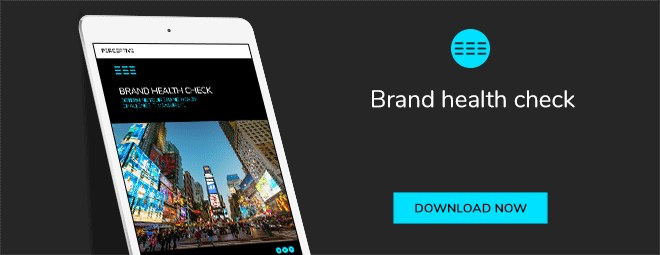To measure your whole brand and get a holistic view of your brand health, you need to find the right metrics to measure rather than measuring isolated metrics that may not present the full picture.

This blog features the most common metrics to measure brand health and performance.
Read more: How to track, measure and improve your brand health, our free online guide.
Behaviour metrics
How does the brand behave? How do our own actions and employee’s behaviour marry up with what we say the brand stands for? It's what employees inside the organisation do to improve and promote a brand.
Countless separate research studies confirm that increased engagement leads to higher financial performance, higher customer satisfaction and higher employee retention.
Behaviour metrics incorporate both internal (management and employees) and external (market-related) factors. Internal branding aligns with leadership and business strategy by reinforcing corporate culture.
It’s important that managers effectively communicate the value proposition to employees and support their teams with the resources needed to achieve organisational goals. If employees understand the brand fully—its values and premise—this means their commitment to the brand will deliver favourable brand experiences to customers.
You can use monthly employee surveys to gather feedback and help ensure that your teams work in a customer-centric way. Your external branding efforts reinforce your customers’ perceptions, customer experience, and the brand value proposition.
Example: Customer satisfaction with recent employee interactions.
Related content: The Leadership Guide To Employee Engagement Strategies [Ebook]
Perception metrics
A strong brand is all about perception. These metrics look at the way a brand is viewed by its customers and other key stakeholders. Brand funnels are one common example.
You’re measuring if customers are aware of your brand and its relevance to them. With the continued rise of social media, brands need real-time data to measure their social initiatives and need to understand how these factors impact their entire brand performance, brand awareness, consideration and trial.
The reason we need to look at more modern versions of funnels is because most of the global internet users search for product reviews online, or feedback from social media sites before making a purchase decision. Word of mouth is now king.
Example: Likelihood of recommendation of brand to friends and family.
Related content: How to trigger word-of-mouth marketing for your business
Brand image metrics
Another measure of perception is brand image. Here, you’re looking at how your brand is perceived in the marketplace.
What do key audiences believe about your brand, and what feelings does your brand induce? If you measure brand equity, you’re tracking the lasting brand perceptions, brand characteristics and what your consumers associate with your brand.
This is crucial as brand perceptions strongly influence how customers think and act. The more positive those perceptions are, the more likely they will be to influence purchase decisions and add value to your business.
If you’re not in a position to fully understand consumer perceptions of your brand, you can’t effectively market your brand and grow your business.
By measuring and quantifying peoples’ perceptions of your brand, you can understand where you stand in the market relative to your competition, what key features of your brand are actually “owned” by competitors, and determine whether customers purchase your product, recommend your company to others, or turn to your competition.
Achieving good brand health always begins with understanding the consumer’s mindset. Use your customers as a starting point when developing and improving your brand (or your products and services).
Example: Recent overall experience rating with brand.
Related content: Identify the moments of truth in your customer journey
Performance metrics
Performance metrics are the financial and other performance measures that drive a company forward, and help you determine your overall brand health.
These metrics evaluate how customers “act” on the perceptions they have formed. They also can help assess how your brand-building initiatives directly drive your results, ranging from price premium to loyalty to the lifetime value of a customer.
Related content: What are the brand tracking KPIs for a brand manger to monitor?
Estimate financial value or your brand equity
Thanks to these measures, you’re able to estimate the accurate financial value of your businesses’ brand equity. It’s therefore important to monitor how the brand is performing relative to overall your business goals, and to measure this from both a financial and customer perspective.
You also want to measure your brand loyalty and how likely it is for your customers to stay your loyal customers. How do customers respond to your brand?
If you’re able to attract a large amount of (high-spending) consumers towards your brands, you’re obviously more likely to be successful. But then, in order for your brand to survive, you need to retain your current customers and to make them loyal to the brand. This is where you measure customer acquisition, retention, and satisfaction all contribute.
In order to measure business impact, you want to look at what your brand’s financial impact is in the marketplace. How do customers act on their thoughts and perceptions about the brand?
Today, your customer brand perceptions and purchasing decisions are increasingly influenced by online communications and social networking platforms.
Automated monitoring to measure word-of-mouth
Gathering negative customer feedback is useful for identifying customer preferences or improving your product if your customers are experiencing issues. Therefore, using an online survey software can be used as early warning system. Automated monitoring is an objective tool for the measurement and analysis of word-of-mouth, because people tend to construct their opinions differently than they might when not being observed.
Finally, conducting market research and using brand perception or recognition surveys to determine how your target customers perceive your brand and if they recognise ir is helpful to know whether your customers associate your brand with the right values, products and services.
Regular data to facilitate decision making
Brand recognition surveys can also be used as a tool to uncover more intangible information, such as consumer perceptions, about your products or services.
All businesses benefit from a comprehensive assessment of their brand, which results in meaningful insights that can facilitate executive decision-making.
Your brand perception becomes more valuable as global competition continues to increase the complexity for all businesses. To provide a comprehensive view as a basis for executive decision making, brands need both up-to-date metrics and data from long-term surveys, and the right metrics to assist brand and marketing teams.
Related content: 4 ways to use Net Promoter Score to improve business performance
To learn more about how to measure and improve your brand health, check out our new e-book Brand Health Check.
